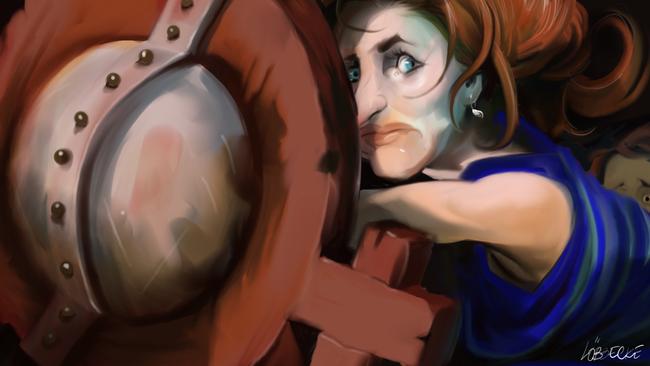There’s no hatred in defending the truths of women and girls

Most people probably aren’t aware that 10 years ago the majority of people wanting to transition to the opposite sex were male. That ratio has now reversed. The UK has experienced a 4400 per cent increase in girls being referred for transitioning treatment. Autistic girls are hugely over-represented in their numbers.
Australia's health minister @GregHuntMP calls on state counterparts to investigate overrepresentation of #autistic teenagers, chiefly girls, in their gender clinics & examine new cautious treatment advice adopted by Britain's @NHSEngland | @australian https://t.co/XIZTdB7bVd
— Bernard Lane (@Bernard_Lane) June 8, 2020
The same has been seen in the US (and Australia). In 2018, American physician Lisa Littman set out to explore it. In an interview, she said: “Parents online were describing a very unusual pattern of transgender identification where multiple friends and even entire friend groups became transgender-identified at the same time. I would have been remiss had I not considered social contagion and peer influences as potential factors.”
Littman mentioned Tumblr, Reddit, Instagram and YouTube as contributing factors to “rapid onset gender dysphoria”, where she believes that in the realm of transgender identification “youth have created particularly insular echo chambers”.
Her paper caused a furore. She was accused of bias and of spreading misinformation about transgender people, subjected to a tsunami of abuse and a concerted campaign to discredit both her and her work.
Littman had dared challenge one of the central tenets of trans activism, which is that a person’s gender identity is innate, like sexual orientation. Nobody, the activists insisted, could ever be persuaded into being trans.
The argument of many trans activists is that if you don’t let a gender dysphoric teenager transition, they will kill themselves. In an article explaining why he resigned from the Tavistock (a National Health Service gender clinic in England), psychotherapist Marcus Evans stated that claims that children will kill themselves if not permitted to transition do not “align substantially with any robust data or studies in this area, nor do they align with the cases I have encountered over decades as a psychotherapist”.
The writings of young trans men reveal a group of notably sensitive and clever people. The more of their accounts of gender dysphoria I’ve read, with their insightful descriptions of anxiety, dissociation, eating disorders, self-harm and self-hatred, the more I’ve wondered whether, if I’d been born 30 years later, I too might have tried to transition. The allure of escaping womanhood would have been huge. I struggled with severe OCD as a teenager. If I’d found community and sympathy online that I couldn’t find in my immediate environment, I believe I could have been persuaded to turn myself into the son my father had openly said he would have preferred.
"We were confident they would not comply with a child’s demands for testosterone and breast removal without exploring what happened to suddenly change her — we were wrong" | World-first book extract from Inventing Transgender Children https://t.co/tI4fMK08BF @australian #ethics
— Bernard Lane (@Bernard_Lane) November 22, 2019
When I read about the theory of gender identity, I remember how mentally sexless I felt in youth. I remember Colette’s description of herself as a “mental hermaphrodite” and Simone de Beauvoir’s words: “It is perfectly natural for the future woman to feel indignant at the limitations posed upon her by her sex. The real question is not why she should reject them: the problem is rather to understand why she accepts them.”
As I didn’t have a realistic possibility of becoming a man back in the 1980s, it had to be books and music that got me through both my mental health issues and the sexualised scrutiny and judgment that sets so many girls to war against their bodies in their teens. Fortunately for me, I found my own sense of otherness and my ambivalence about being a woman reflected in the work of female writers and musicians who reassured me that — in spite of everything a sexist world tries to throw at the female-bodied — it’s fine not to feel pink, frilly and compliant inside your own head; it’s OK to feel confused, dark, both sexual and non-sexual, unsure of what or who you are.
I want to be very clear here: I know transition will be a solution for some gender dysphoric people, although I’m also aware through extensive research that studies have consistently shown that between 60 and 90 per cent of gender dysphoric teens will grow out of their dysphoria. Again and again I’ve been told to “just meet some trans people”. I have: in addition to a few younger people, who were all adorable, I happen to know a self-described transsexual woman who’s older than I am and wonderful. Although she’s open about her past as a gay man, I’ve always found it hard to think of her as anything other than a woman, and I believe (and certainly hope) she is completely happy to have transitioned. Being older, though, she went through a long and rigorous process of evaluation, psychotherapy and staged transformation. The current explosion of trans activism is urging a removal of almost all the robust systems through which candidates for sex reassignment were once required to pass.
Never have I seen women denigrated and dehumanised to the extent they are now. From the leader of the free world’s long history of sexual assault accusations and his proud boast of “grabbing them by the pussy”, to the incel (“involuntarily celibate”) movement raging against women who won’t give them sex, to the trans activists who declare that TERFs (trans-exclusionary radical feminists) need punching and re-educating, men across the political spectrum seem to agree: women are asking for trouble. Everywhere, women are being told to shut up and sit down, or else.
@jk_rowling is right whereas Daniel Radcliffe is wrong to insinuate that people who are offended by free speech are entitled to sympathy & moral restitution for their pain, says @thetimes leader. https://t.co/54jprXCe1L
— Oliver Kamm (@OliverKamm) June 10, 2020
I’ve read all the arguments about femaleness not residing in the sexed body, and the assertions that biological women don’t have common experiences, and I find them deeply misogynistic and regressive. It’s also clear that one of the objectives of denying the importance of sex is to erode what some seem to see as the cruelly segregationist idea of women having their own biological realities or — just as threatening — unifying realities that make them a cohesive political class.
But, as many women have said before me, “woman” is not a costume. “Woman” is not an idea in a man’s head. “Woman” is not a pink brain, a liking for Jimmy Choos or any of the other sexist ideas now somehow touted as progressive. Moreover, the “inclusive” language that calls female people “menstruators” or “people with vulvas” strikes many women as dehumanising and demeaning. I understand why trans activists consider this language to be appropriate and kind, but for those of us who’ve had degrading slurs spat at us by violent men, it’s not neutral. It’s hostile and alienating.
This is an edited extract of JK Rowling’s open letter on sex and gender.






I’m concerned about the huge explosion in young women wishing to (undergo gender) transition, and also about the increasing numbers who seem to be detransitioning (returning to their original sex) because they regret taking steps that have, in some cases, altered their bodies irrevocably and taken away their fertility. Some say they decided to transition after realising they were same-sex attracted and that transitioning was partly driven by homophobia, either in society or in their families.